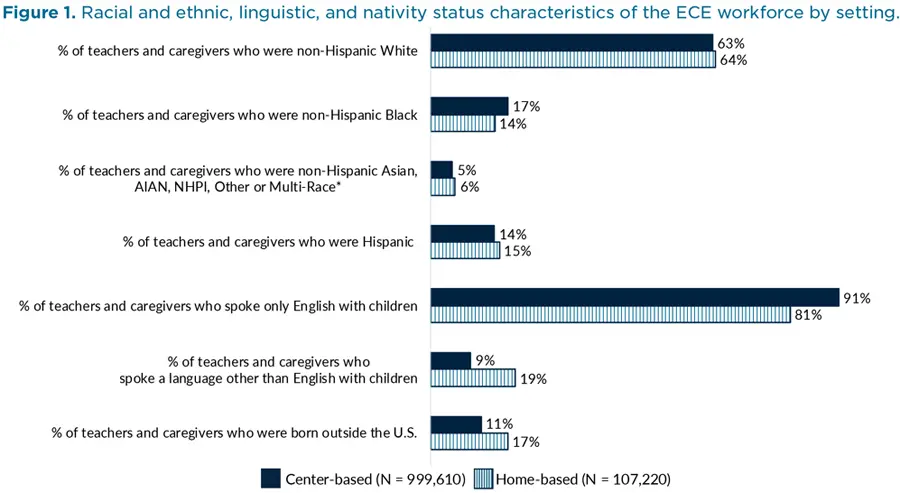Professional Characteristics of the Early Care and Education Workforce: Descriptions by Race, Ethnicity, Languages Spoken, and Nativity Status
Racial and ethnic, linguistic, and cultural diversity in early care and education (ECE) settings are emerging as critically important aspects of provider quality. As of 2012, nearly half of young children under age 5 were children of color and/or Hispanic, 22 percent spoke a language other than English at home,1 and 24 percent lived in immigrant households.2 Young children from a variety of racial and ethnic, cultural, and linguistic backgrounds benefit from culturally diverse experiences in the classroom, as well as experiences that support their households’ cultural background (Reid & Kagan, 2015).
This report presents a national portrait of center-based and home-based ECE teachers and caregivers from the 2012 National Survey of Early Care and Education (NSECE). It describes the professional characteristics and motivations of teachers and caregivers working in center-based and home-based settings by race and Hispanic ethnicity, languages spoken, and nativity status.
Key findings
Different patterns of professional characteristics emerged between teachers and caregivers from different demographic backgrounds. Teachers and caregivers who identified as a person of color, who spoke a language other than English or multiple languages with children, and/or who were born outside the United States had lower rates of bachelor’s degree attainment and were more likely to access continuing education and professional development opportunities than teachers and caregivers who identified as White, spoke only English with children, and/or who were born in the United States. In addition, motivations for working in the ECE field varied by racial and ethnic identity and languages spoken. A selection of key findings is presented below.

Source: Authors’ analysis of the 2012 NSECE center-based workforce survey public use data and the 2012 NSECE home-based provider survey public use data. Totals reflect the population of teachers and caregivers in each setting. Totals are rounded to the nearest 10.
*This category of non-Hispanic race includes anyone self-identifying as Asian, American Indian or Alaska Native, Native Hawaiian or other Pacific Islander, Other or Multi-Race.
- The ECE workforce in each setting (centers and homes) reflected the racial and ethnic makeup of adults in the United States in 2012. However, as a companion report illustrates (Paschall, Madill, & Halle, 2020), teachers and caregivers do not necessarily reflect the racial and ethnic makeup of children who use ECE.
- Teachers and caregivers in both centers and homes who identified as Hispanic or non-Hispanic Black, and who spoke a language other than English with children, were more likely to have a Child Development Associate (CDA) credential or a state certificate or endorsement and less likely to have a bachelor’s degree, relative to those who were non-Hispanic White or who spoke only English with children, respectively. A higher proportion of teachers and caregivers in centers and homes who were born outside of the United States had CDAs or state certifications to teach young children, compared with those born in the United States.
- Teachers and caregivers in both centers and homes who identified as Hispanic or non-Hispanic Black and/or who spoke a non-English language with children were more engaged in professional development opportunities than non-Hispanic White and/or English-only speaking teachers and caregivers, including college course enrollment, working with a coach or mentor, and professional organization membership.
Although the study is, overall, representative of ECE providers in the United States in 2012, small sample sizes for some subgroups yields limited precision (e.g., non-Hispanic other race,3 speaking a language other than English or Spanish). To further confirm the findings, future studies should replicate analyses with larger sample sizes and disaggregate racial and linguistic groups as possible. In addition, teachers and caregivers who were born outside the United States, those who identified as a person of color and/or Hispanic, and those who spoke a language other than English with children are each a diverse group in their own right, representing a multitude of racial and ethnic, linguistic, geographic, and cultural backgrounds. Although combined here due to sample size limitations, each unique subgroup may have distinct ECE professional characteristics and may require specific supports to promote their professional development.
View
This brief is part of the Child Care and Early Education Policy and Research Analysis (CCEEPRA) project. CCEEPRA supports policy and program planning and decision-making with rigorous, research-based information.
Footnotes
© Copyright 2024 ChildTrendsPrivacy Statement
Newsletter SignupLinkedInThreadsYouTube